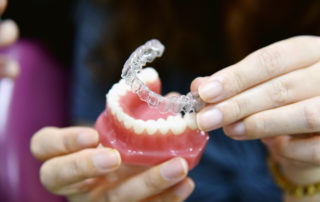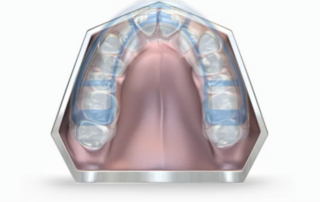Friendly Orthodontics Tips and Guidance
First Things First: Orthodontics Care
While we continuously focus on the latest updates in orthodontics care, how we’re improving, and how you can have the smile you want without all the pain that is generally associated with orthodontics, we also have tips for at home dental and orthodontic care you might have missed. Here’s some key points not to miss!
Latest Articles from Ahava Orthodontics
Lost Or Broken Retainer? What To Do Next
A lost retainer can play a big role in whether your teeth remain straight or not. You probably wore your braces for at least a year and perhaps even longer. While the braces did the heavy lifting to get your teeth in their perfect positions, your retainer should be worn daily to keep your teeth in their intended positions. Retainers are responsible for keeping your teeth straight after your braces have been removed and if you go too long without yours, you might eventually notice that your teeth have shifted. So what are you to do if you find yourself without a trace of your retainer?Ways To Avoid Lost Retainers The best way to avoid losing your [...]
Ahava Orthodontics Is #1 in Fort Worth For Invisalign Treatment
At Ahava Orthodontics, our biggest goal is to provide exceptional orthodontic care in a loving and welcoming atmosphere. Dr. Barron is certified by Align Technology to provide Invisalign treatment. His experience and care for his patients make his service second to none. Ahava has been providing Invisalign treatment to patients in the Fort Worth area for years and we would love to have you as part of our Ahava family. What is Invisalign? Invisalign, or the “clear aligner”, is a system with the same goals of traditional braces, without the metallic appearance that braces are associated with. Invisalign is a clear retainer treatment option that is easy to clean and maintain during day to day activities. While you may [...]
Can Retainers Help Realign My Teeth?
Many people associate retainers with post-braces care, but can they actually help realign teeth on their own? While retainers play a crucial role in maintaining orthodontic results, they are sometimes used to make minor corrections to teeth alignment. If your teeth have shifted slightly over time or you’re wondering whether a retainer can straighten them without needing braces, this article will help you understand what retainers can and can’t do. At Ahava Orthodontics in Fort Worth, Dr. Shawne Barron helps patients of all ages find the best orthodontic solutions for their smiles. Here’s everything you need to know about whether retainers can help realign your teeth. What Are Retainers and How Do They Work? A retainer is a custom-made [...]
Common Questions Parents Ask About Braces For Their Child
When it comes to your child’s dental health, you want to make the best decisions to ensure they grow up with a healthy, confident smile. If your child needs braces, you probably have a lot of questions about the process, costs, and what to expect. At Ahava Orthodontics in Fort Worth, Dr. Shawne Barron and her team are here to help parents navigate the orthodontic journey with ease. Below are some of the most common questions parents ask about braces for their child. You try to protect your child from physical injuries like broken bones and skinned knees, but have you considered how to provide for their oral care to avoid dental and orthodontic issues as adults? Early visits [...]
Naturally Straighten Teeth: Why Braces Are Your Best Option
In the quest for a perfectly aligned smile, braces are often the most effective and natural method for straightening teeth. At Ahava Orthodontics in Fort Worth, we specialize in transforming smiles through carefully planned orthodontic treatment. This blog explores why braces, administered under the expert care of an orthodontist, are considered the best and most natural option for achieving straight teeth and how they contribute to long-term oral health. The Role of Orthodontics in Natural Tooth Alignment Orthodontics is more than just the science of moving teeth; it's a comprehensive approach to aligning teeth and jaws to improve dental function and aesthetic appearance. Braces, whether traditional, ceramic, or lingual, apply gentle, continuous pressure over time to move teeth into [...]
How You Can Know If Your Child’s Jaw Is Too Small
As a parent, you want to ensure that your child’s dental and facial development is on the right track. One common concern in growing children is whether their jaw is too small. A small or underdeveloped jaw can lead to crowded teeth, bite issues, and other complications that may require early intervention. Recognizing the signs of a small jaw and understanding when to seek help are key to supporting your child’s healthy growth. At Ahava Orthodontics in Fort Worth, Dr. Andy and Shawne Barron specialize in identifying and treating jaw development concerns, helping children achieve healthy, balanced smiles. Here’s everything you need to know about spotting a small jaw in your child and how early orthodontic care can make [...]
Orthodontist vs. Dentist: When to Call the Orthodontist
When it comes to enhancing your smile or addressing dental alignment issues, deciding whether to see an orthodontist or a dentist can be pivotal. While both professionals play integral roles in maintaining oral health, their areas of expertise, especially concerning orthodontic treatment, differ significantly. At Ahava Orthodontics in Fort Worth, we understand the importance of making informed decisions about your oral health care. This guide aims to clarify the distinctions between orthodontists and dentists, helping you choose the right professional for your orthodontic needs. The Role of Dentists and Orthodontists Dentists: The General Practitioners of Oral Health: Dentists are akin to general practitioners in the medical field. They diagnose, treat, and manage your overall oral health care [...]
If Your Child is a Mouth Breather, They’re at Risk of Swollen Adenoids
Mouth breathing is a common issue in children, often overlooked because it seems harmless. However, persistent mouth breathing can lead to serious health concerns, including swollen adenoids. Adenoids are small patches of tissue located in the back of the nasal cavity that play a role in the immune system. When they become swollen, they can cause a cascade of problems, from sleep disturbances to facial development issues. Understanding the connection between mouth breathing and swollen adenoids is crucial for protecting your child’s health. What Are Adenoids and Why Are They Important? Adenoids are small, spongy patches of lymphatic tissue located in the upper part of the throat, just behind the nasal cavity. Together with the tonsils, they [...]
How Thumb and Finger Sucking Affect Your Childs Teeth
Thumb and finger sucking is a natural reflex for babies and young children. It provides comfort, self-soothing, and even helps infants feel secure as they navigate the world. However, when this habit persists beyond the toddler years, it can lead to significant dental and orthodontic problems that may require intervention. Understanding the impact of thumb and finger sucking on your child’s teeth and jaw development can help you address the habit early and protect their oral health. Why Do Children Suck Their Thumbs or Fingers? Thumb and finger sucking is an innate reflex that begins even before birth. Ultrasounds have shown babies sucking their thumbs in the womb. After birth, this behavior helps infants self-soothe, sleep better, and feel [...]
How the Myobrace Helps with Health and Development
The Myobrace System is an innovative orthodontic treatment that goes beyond just straightening teeth. Unlike traditional braces, which primarily focus on correcting misalignment, Myobrace addresses the root causes of crooked teeth by correcting poor oral habits, encouraging proper jaw growth, and supporting overall health. This pre-orthodontic approach is suitable for children as young as three and has benefits that extend well beyond dental alignment, impacting areas such as breathing, sleep, and facial development. Here’s how the Myobrace System promotes both health and development in children, making it a powerful, preventive solution for families seeking more than just a straight smile. Encourages Proper Jaw Development A common reason for crowded or misaligned teeth is underdeveloped jaws, which may [...]










